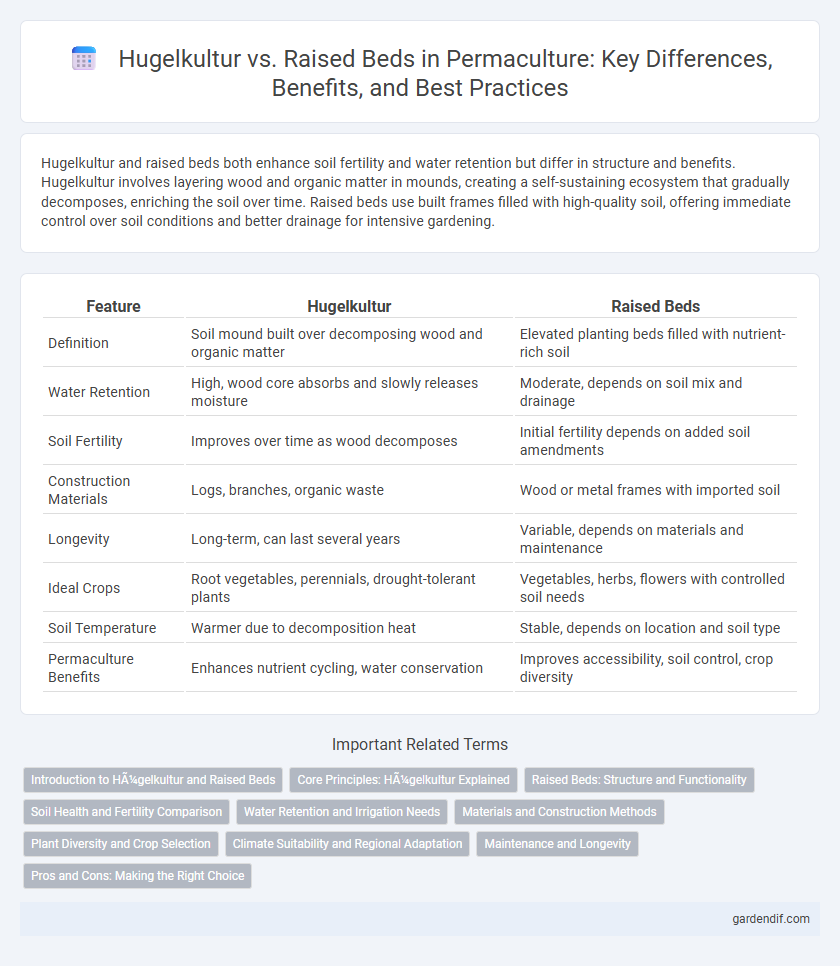
Hügelkultur vs Raised Beds Illustration
Hugelkultur and raised beds both enhance soil fertility and water retention but differ in structure and benefits. Hugelkultur involves layering wood and organic matter in mounds, creating a self-sustaining ecosystem that gradually decomposes, enriching the soil over time. Raised beds use built frames filled with high-quality soil, offering immediate control over soil conditions and better drainage for intensive gardening.
Table of Comparison
| Feature | Hugelkultur | Raised Beds |
|---|---|---|
| Definition | Soil mound built over decomposing wood and organic matter | Elevated planting beds filled with nutrient-rich soil |
| Water Retention | High, wood core absorbs and slowly releases moisture | Moderate, depends on soil mix and drainage |
| Soil Fertility | Improves over time as wood decomposes | Initial fertility depends on added soil amendments |
| Construction Materials | Logs, branches, organic waste | Wood or metal frames with imported soil |
| Longevity | Long-term, can last several years | Variable, depends on materials and maintenance |
| Ideal Crops | Root vegetables, perennials, drought-tolerant plants | Vegetables, herbs, flowers with controlled soil needs |
| Soil Temperature | Warmer due to decomposition heat | Stable, depends on location and soil type |
| Permaculture Benefits | Enhances nutrient cycling, water conservation | Improves accessibility, soil control, crop diversity |
Introduction to Hügelkultur and Raised Beds
Hugelkultur is a permaculture technique that involves creating raised garden beds by piling decomposing wood, branches, and organic matter to build nutrient-rich, moisture-retentive soil mounds. Raised beds, in contrast, consist of garden plots elevated above the ground and filled with high-quality soil or compost to improve drainage, soil structure, and root growth. Both methods enhance plant health and soil fertility, but Hugelkultur leverages natural decomposition processes while raised beds emphasize controlled soil composition.
Core Principles: Hügelkultur Explained
Hugelkultur is a permaculture technique that emphasizes creating raised garden beds by layering decomposing wood, organic matter, and soil, which enhances water retention, soil fertility, and microbial activity. Unlike traditional raised beds that rely primarily on added soil, Hugelkultur mimics natural forest ecosystems, promoting nutrient cycling and extended moisture availability. This method supports sustainable gardening by recycling biomass and improving plant resilience through deep root zones and improved aeration.
Raised Beds: Structure and Functionality
Raised beds offer a highly efficient gardening structure characterized by elevated soil levels that improve drainage, soil aeration, and root penetration. Their design supports optimal soil layering and nutrient management, fostering healthier plant growth and easier maintenance compared to traditional in-ground beds. This structure also enhances accessibility and temperature control, making raised beds ideal for diverse climates and permaculture practices.
Soil Health and Fertility Comparison
Hugelkultur and raised beds both enhance soil health but differ in their approaches to fertility. Hugelkultur uses decomposing wood and organic matter to improve moisture retention, nutrient cycling, and microbial activity over time, creating a self-sustaining nutrient source. In contrast, raised beds provide improved drainage and aeration while relying more on external compost and amendments for sustained fertility.
Water Retention and Irrigation Needs
Hugelkultur beds excel in water retention by using decomposing wood and organic matter, which acts as a natural sponge, reducing irrigation needs significantly. Raised beds generally require more frequent watering as they lack the internal moisture storage capabilities found in hugelkultur systems. The enhanced water-holding capacity of hugelkultur makes it a sustainable choice for permaculture gardens in drought-prone areas.
Materials and Construction Methods
Hugelkultur uses decomposing wood, branches, leaves, and organic matter piled beneath soil to create nutrient-rich, moisture-retaining mounds, emphasizing natural decomposition processes. Raised beds typically rely on stacked wooden frames filled with a mix of topsoil, compost, and other amendments, allowing precise control over soil quality and structure. Hugelkultur integrates layers of biomass that break down over time, while raised beds prioritize manageable soil profiles for planting and irrigation flexibility.
Plant Diversity and Crop Selection
Hugelkultur beds offer superior water retention and nutrient cycling, supporting a wider range of plant species, including deep-rooted perennials and nutrient-demanding crops. Raised beds provide better soil control and drainage, ideal for intensive planting of vegetables and herbs requiring specific soil conditions. Both methods enhance plant diversity, but hugelkultur favors long-term ecosystem development while raised beds enable precise crop rotation and specialization.
Climate Suitability and Regional Adaptation
Hugelkultur excels in temperate and humid climates by maximizing moisture retention and soil warming through decomposing wood layers, making it ideal for regions with moderate rainfall and cooler seasons. Raised beds offer greater flexibility across diverse climates, enabling improved drainage in wet areas and soil warming in colder zones when combined with solar exposure. Both methods require regional adaptation, with Hugelkultur suited for areas where wood is abundant and decomposition rates are moderate, while raised beds perform well in urban or arid environments needing precise soil and water management.
Maintenance and Longevity
Hugelkultur beds require minimal maintenance due to their self-sustaining decomposition process, which enhances soil fertility over time by gradually breaking down wood and organic matter. Raised beds demand more frequent upkeep, including soil replenishment and weed control, to maintain optimal growing conditions since they lack the slow-release nutrients provided by Hugelkultur. In terms of longevity, Hugelkultur beds can last several years or even decades as the buried wood decomposes slowly, whereas raised beds typically need soil replacement or bed reconstruction every few seasons to sustain productivity.
Pros and Cons: Making the Right Choice
Hugelkultur offers superior moisture retention and nutrient cycling due to its decomposing wood core, making it ideal for drought-prone areas, while raised beds provide better soil control and accessibility, especially in compact urban gardens. However, Hugelkultur requires more initial labor and space, whereas raised beds can suffer from rapid soil drying and require frequent watering. Choosing between them depends on climate conditions, garden size, and maintenance capacity to optimize plant growth and soil health.
Hügelkultur vs Raised Beds Infographic

 gardendif.com
gardendif.com